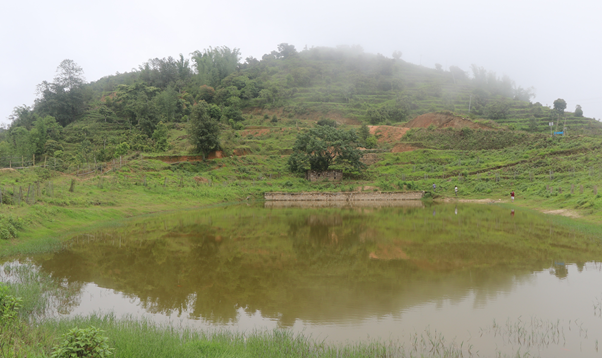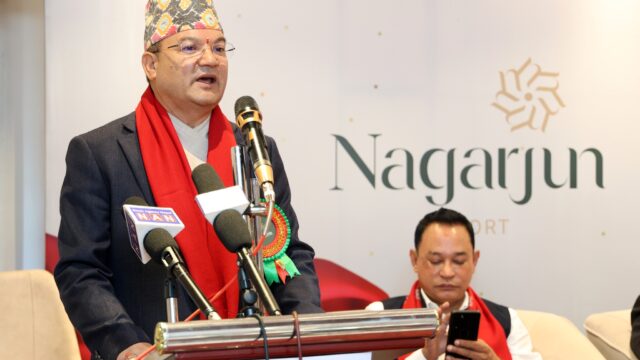Hongma Pokhari, Nestled at an altitude of approximately 1,500 meters above sea level in Chisapani of Jantedhunga Rural Municipality–5. The serene and culturally significant Hongma Pokhari remains largely hidden from Nepal’s mainstream tourism map. Surrounded by blooming rhododendrons, chimals, and indrakamals, as well as fruit-bearing trees like pomegranates, pears, and apples, this naturally formed pond is a picturesque and spiritual site rich with untapped tourism potential.
Despite its enchanting charm and deep-rooted cultural value, locals lament that the pond still waits for active tourism promotion and sustainable development. They believe that with proper conservation and publicity, Hongma Pokhari could flourish as a thriving internal tourism destination in eastern Nepal.
A Pond of Beauty, Myths, and Sacred Traditions
Hongma Pokhari is not just a scenic water body, it is culturally revered by both Hindu and Kirat communities. The pond, which maintains water year-round and is home to strikingly red fish, occupies about 12 ropanis of government land. According to local elder Vigyan Rai, the pond is surrounded by lush green hills and lies near a rural road that connects Khotang’s Bhanyangkharka to neighboring Bhojpur district, boosting its accessibility.
The pond’s name, Hongma, has roots in Kirat Rai Bantawa language, where it means to wait or to hide. Historically, during the hunter-gatherer era, local Kirat communities would lie in wait for animals that came to drink from the pond, thus the origin of its name. Adding to its spiritual value, Hongma Thaan, located on the southern side of the pond, is a sacred site where people gather to offer prayers during Baishakh Purnima every year.
Moreover, Hindu mythology links Hongma Pokhari to the ancient Barah Pokhari, as mentioned in the Himavat Khanda Purana. It is believed that Lord Vishnu bathed in Barah Pokhari while visiting his daughter Bhanu Mati. This mythical connection between Barah and Hongma Pokhari adds further spiritual significance, making it an attractive site for pilgrims and tourists alike.
Development Efforts and Budget Limitations
Recognizing its historical and religious value, local and provincial governments have made initial efforts to improve the pond’s condition. According to Khem Bahadur Khadka, Vice Chairperson of Jantedhunga Rural Municipality, the local ward office allocated NPR 1 million, while the Koshi Province Government allocated another NPR 1 million four years ago and NPR 500,000 two years ago. These funds were used to build a stone embankment and fencing, plant fruit-bearing trees, and beautify the surroundings.
However, the Vice Chairperson expressed concern that since the fiscal year 2079/80, no additional budget from the federal or provincial governments, beyond basic grants and equalization funds, has been made available. “Due to limited financial resources, especially during monsoon when the water turns murky, the red fish population is at risk,” said Khadka. “Our municipality alone cannot bear the cost of preservation and promotion. We’ve requested funding from the Ministry of Culture, Tourism, and Civil Aviation, but no response has been received yet.”
Festivals, Rituals, and Growing Footfall
Despite its limited infrastructure, Hongma Pokhari has seen increasing footfall from both internal and regional tourists, especially after the establishment of the local government, which initiated conservation work. Local resident Birbal Kirati shared that a large fair is organized the day after the major religious event at Barah Pokhari, and many pilgrims also visit Hongma Pokhari for rituals and blessings.
Another unique feature of the pond is the dual worship tradition, while Hindu devotees offer pigeons and goat sacrifices, Kirat communities offer roosters during festivals such as Baishakh Purnima and Guru Purnima. These traditions, passed down over generations, have fostered a cultural confluence that can greatly appeal to spiritual and cultural tourists.
Private Sector Investment and Future Prospects
Jantedhunga Rural Municipality Chairperson Arunadevi Rai informed that efforts are now underway to attract private sector investment in the pond’s development. The municipality has created a policy framework allowing private entities to plant uniform orchards and construct eco-friendly guest facilities around the pond.
“This is a historical and spiritual pond. We are actively working to develop it into a tourism destination by preserving and promoting its heritage,” Rai said. “The pond has also been mentioned in Kirat mythology, which further strengthens its uniqueness.”
According to her, local government investment has already helped with road development connecting Hongma Pokhari to major routes, making it easier for visitors to reach the site. This opens up possibilities for community-based tourism, eco-lodging, and guided tours that celebrate the area’s natural beauty and spiritual heritage.
A Hidden Jewel Waiting for National Attention
Despite being steeped in mythology, tradition, and natural beauty, Hongma Pokhari has been largely overlooked at the national level. While local authorities have taken commendable steps in preserving this sacred site, they continue to struggle with limited resources and institutional support.
If national tourism policies prioritized culturally rich and lesser-known destinations like Hongma Pokhari, it could significantly boost internal tourism and support rural economies. Additionally, it would help preserve Nepal’s diverse religious and cultural heritage, offering new experiences to travelers and fulfilling long-standing demands of local communities.
As the nation looks toward diversifying its tourism offerings, it is time for government bodies, cultural agencies, and private investors to recognize the immense potential of Hongma Pokhari, not just as a spiritual site, but as a model of sustainable rural tourism rooted in tradition, natural beauty, and community pride.






